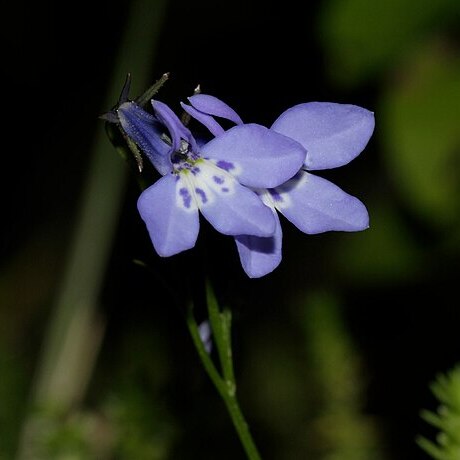An erect herb. It grows 5-60 cm tall. It grows each year from seed or can last a few years. The stem is angular with narrow wings. The leaves are 2-7 cm long and about 1 cm wide. There can be teeth along the edge. The flowers are in loose groups and are white, mauve or blue. The fruit is a capsule 1.5 mm long.
Leaves (5)20–70 x 2–10(17) mm., crenate to serrate or subpinnatifid, the upper linear to lanceolate, the lower linear to spathulate or suborbicular, acute to obtuse at the apex, sessile or narrowing below into a petiole–like base or an up to 7 mm. long petiole, glabrous or lower leaves ± pubescent.
Flowers in lax racemes; pedicels 5–50 mm. long, glabrous or papillose to short pubescent; bracts similar to upper stem leaves, shorter to longer than the pedicels; bracteoles c. 0·4–1·6 mm. long, linear, at or near the base of the pedicel.
Corolla 8–15 mm. long, blue, mauve or white, with two bumps in the mouth of the tube, split to 0·3·1·5 mm. from the base on the back, papillose on the inside of the tube, glabrous or pubescent on the outside.
Anther–tube (1·2)2–2·4 mm. long, ± pubescent on the back of the upper thecae, or glabrous, the two lower anthers each with a tuft of hairs and a hyaline appendage at the apex.
Calyx–lobes narrowly triangular, erect or spreading, 1·2–6 mm. long, with one to three pairs of teeth at the margin or entire, glabrous or ciliate to pubescent.
Filaments linear, puberulous at the base or ± along their entire length, attached to the corolla–tube at the base.
Seeds elliptic to broadly elliptic in outline, somewhat compressed, 0·35–0·5 mm. long, very finely striate, brown.
Hypanthium narrowly obconical to obovoid, 8–10–nerved, glabrous or papillose to short pubescent.
Stem angular, narrowly winged, glabrous or pubescent on the wings with rather rigid hairs.
Capsule 8–10–nerved with 2 valves 1–1·5 mm. long, inferior part of capsule 3–7 mm. long.
Annual or short–lived perennial, decumbent to erect herb, 5–60 cm. tall.
Ovary subinferior.

